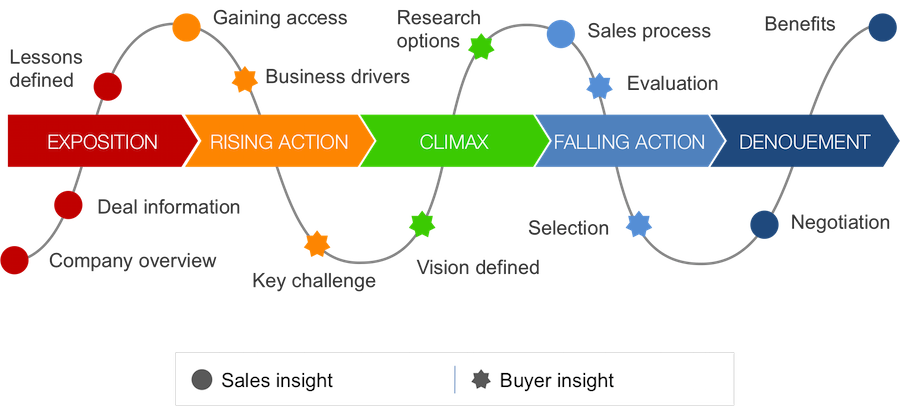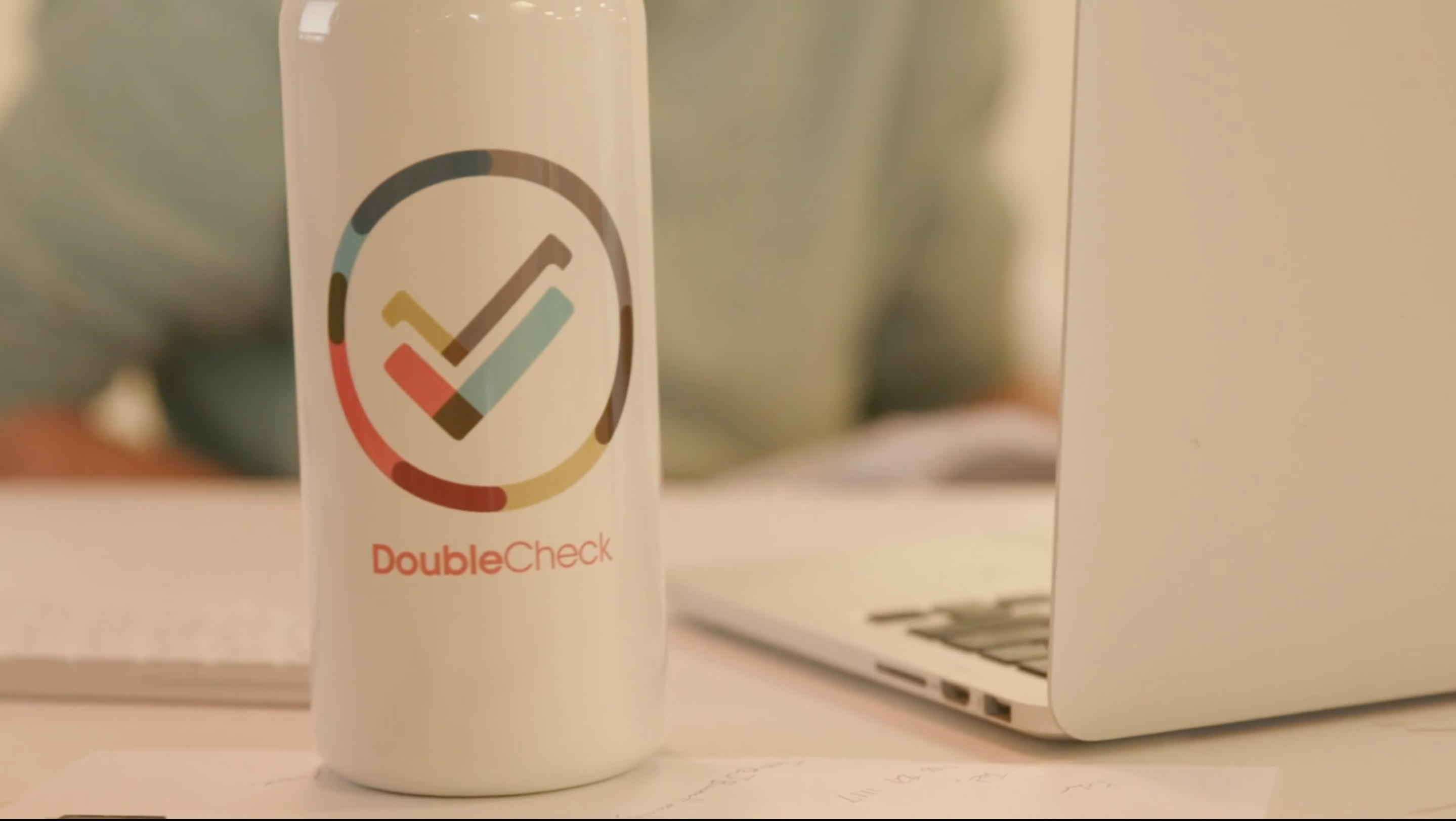Impactful Storytelling
In life, it is great stories that captivate an audience, create emotion, teach lessons, and drive behavior. While some of us are natural storytellers, others are not, but wish to be.
Today, many organizations capture and share stories of victory and loss, recognizing the importance of recapping key details as a way to create awareness and as a vehicle to help others grow. The challenge is that few truly understand what makes for a great story. To make matters worse, these stories are regularly told from a sales perspective and rarely include the buyer’s view. As a result, the impact of the stories told is not quite as big as it could be, and the opportunity to impart multidimensional wisdom often falls short. So, in a world of one-sided stories told by non-storytellers, how do we create more great win-loss stories?
Freytag's Pyramid
In 1863, after years of analyzing the works of ancient Greek and Shakespearean dramas, German playwright and novelist Gustav Freytag published Freytag’s Pyramid.
According to Freytag, every great story is divided into five parts, or acts, which some refer to as a dramatic arc: exposition, rising action, climax, falling action, and dénouement. By applying Freytag’s framework, one can quickly transform a mishmash of experiences and insights into a story worth telling.
Leveraging Freytag’s work and creating an opportunity for the buyer’s voice to be heard, this article offers a new framework for telling win-loss stories from the field that teach, drive change, and inspire others.

Act 1: Exposition
Every win-loss story must have a beginning. The start, or exposition, is where the characters and setting are established. During this part of the win-loss story, the main problem is also introduced.
👀 Scene 1: Company Overview
The story opens with a background slide that was designed to ready the audience for what’s to come. At this point, key information about the company is profiled:
- Short description
- Industry
- Main competitors
- Revenue
- Headlines, if applicable
🔖 Scene 2: Deal Information
Following the company overview, the storyteller narrows the focus to the deal in question. To do this, more specific information is offered:
- Products considered
- Deal size
- Outcome (win, loss, or no decision)
- Stakeholder and their influence on the decision
- Incumbent and competition
👍 Scene 3: Lessons you will learn
With the proper overview information provided, it is time to set the audience’s expectations regarding what they will learn from the story. Highlighting the key takeaways upfront will help focus the group’s attention. Typical lessons fall into areas such as the following:
- Overcoming objections
- Navigating the organization
- Differentiating from the competition
Act 2: Rising Action: Introduction of the problem, conflict, and driver
The rising action is a series of events and actions that move the story to a climax. During the rising action, the basic business challenge is outlined, including the obstacles preventing the individual, client/prospect org-anization, and/or salesperson from achieving their goals.
🚪Scene 1: Getting Through the Door
A great way to begin Act 2 is with an interesting account of how the sales team was able to get through the door and ultimately be considered. The account often includes recognizing the efforts and actions of many, and reviews how the following resources were leveraged:
- Marketing-driven activities
- Internal or external referrals
- Personalized “why you, why now” communications
- Key events
🏋️ Scene 2: Business Drivers/Key Challenges
The next scene introduces the buyer and the reason why he or she was looking for a new solution. At this point, we suggest that a co-presenter step in to present the buyer’s feedback that was previously collected during the win-loss interview process. The back and forth between the salesperson and this buyer representative creates an interesting dynamic, and helps to keep the audience’s attention. Business driver/key challenge reasons might include the following:
- Issues with the incumbent
- New business strategy or direction
- New leadership
- New laws
Act 3: Climax
The climax is the high point in the story. The actions thus far have led our characters to this important point where things will begin to look up or take a turn for the worst. For the buyer, the climax may represent a heightened level of awareness of a solution to the problem. The buyer may have arrived at this place due to extensive research he or she conducted prior to engaging providers. For the salesperson, this critical point may represent being formally invited into the evaluation process.
🤓 Scene 1: Vision for a Solution
In this scene, the buyer representative shares the vision for a solution and partner preferences, which will likely include strategic benefits and tactical requirements:
- Efficiencies gained (time, financial, and/or resources)
- Competitive advantage gained
- Ability to better serve clients
- Specific functionality
- Delivery model
- Cultural alignment
- Resource availability
👩💻 Scene 2: Researching Options
Once the vision is presented, the buyer representative will provide an overview of the resources leveraged to create his or her vendor target list. Information shared includes the following:
- Providers in consideration
- Process for creating the target list
- Resources leveraged (peer network, analyst research, and/or trade show, etc.)
- Key influencers
Act 4: Falling Action
During the falling action, our buyer reviews each solution option and makes a selection. The falling action includes the buyer’s and seller’s view into the sales process. As the sales team awaits the final decision, the falling action may also introduce a moment of suspense in which the outcome is in question.
🔂 Scene 1: Sales Process
Here, the seller is presented with an opportunity to give his or her view of the sales process. The seller will often share the steps taken to get on the shortlist, and provide insight into the techniques applied to improve the odds, overcome objections, and differentiate from the competition. The audience tends to listen closely during this part of the story, since the following important questions are answered:
- What lessons are worth sharing regarding what worked and what did not work?
- What types of objections were presented, and how were they addressed?
- What would you do differently, given the chance?
✍️ Scene 2: Evaluations and Decision-making
Falling action closes with the buyer’s recap of the evaluation and decision-making process. This section always provides rich content, since it is the place to hear the following:
- Key decision-making criteria
- Thoughts on the demo process
- Thoughts on the client reference process
- Opinion of the competition
- Opinion of the winner
Act 5: Denouement (The End)
All great stories must come to an end. In the case of a win, we learn of the salesperson’s final push across the line to victory. The buyer, now a client, will conclude with his or her hopes and dreams for this new relationship.
In the case of a loss, the story will take on the form of a cautionary tale. As true sales leaders often do, the seller will provide advice based on the lessons learned and share his or her plans for integrating those lessons into future sales cycles. The seller may also share how he or she plans on keeping in contact with the buyer with the hope of landing future business.
Did you enjoy this blog article? Check out some of our other awesome content.
Become a DoubleCheck Insider!


